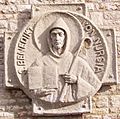Abbot facts for kids
An abbot is like the principal or leader of a special religious community called a monastery. In a monastery, people called monks live together, dedicating their lives to prayer, study, and work. The word "abbot" comes from an old word meaning "father," showing their role as a spiritual guide and head of the monastic family. For women, the leader of a nunnery or convent is called an abbess.
What is a Monastery?
A monastery is a building or group of buildings where monks or nuns live together. They follow a specific set of rules, often called a "Rule," which guides their daily lives. These rules usually include things like prayer, work, and silence. Monasteries have been important centers of learning and culture throughout history.
The Role of an Abbot
The abbot is the spiritual and administrative head of a monastery. Think of them as the leader of a large family or a small village. Their main jobs include:
- Spiritual Guide: The abbot helps the monks grow in their faith and understanding. They offer advice, lead prayers, and teach about religious life.
- Manager: They are responsible for the daily running of the monastery. This includes managing its finances, buildings, and lands.
- Teacher: Abbots often teach the younger monks about the monastic way of life and the traditions of their order.
- Representative: They represent the monastery to the outside world, including other religious leaders and the local community.
Monks usually choose their abbot through an election. Once chosen, an abbot serves for a specific term or sometimes for life, depending on the rules of their religious order.
History of Abbots
The idea of an abbot began very early in Christian history. In the first few centuries, some Christians chose to live alone in deserts as hermits. Over time, these hermits started to gather in communities for support and guidance. The oldest monk in the group naturally became the leader, and people started calling him "Abba," which means "father" in Aramaic.
One of the most famous figures in monastic history is Saint Benedict of Nursia. In the 6th century, he wrote a "Rule for Monasteries" that became very important. This rule clearly defined the role of the abbot as the spiritual father and leader of the community. Many monasteries around the world still follow Saint Benedict's Rule today.
Over the centuries, abbots became very powerful and respected figures. Some abbots even had influence in politics and society, not just within their monasteries. Today, abbots continue to play a vital role in guiding monastic life and preserving ancient traditions.
Images for kids
-
Coptic icon of Saint Pachomius, the founder of cenobitic monasticism
-
Carving of Saint Benedict of Nursia, holding an abbot's crozier and his Rule for Monasteries (Münsterschwarzach, Germany)
-
Abbot Francis Michael and Prior Anthony Delisi (on the left) of Monastery of the Holy Spirit, a Trappist monastery in Conyers, Georgia, US.
-
"The Abbot", from the Dance of Death, by Hans Holbein the Younger
See also
 In Spanish: Abad para niños
In Spanish: Abad para niños








